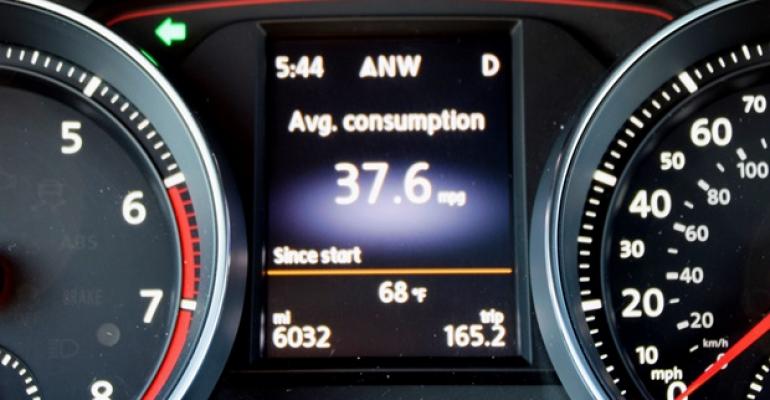Wolfsburg enthusiasts must consider this the Holy Trinity among 4-cyl. turbocharged gasoline engines. Lord knows, there are lots of good new ones in the market, and Volkswagen has done its best to claim benchmark status for overall performance, smoothness and value.
Powering all three are members of Volkswagen’s excellent new direct-injected turbocharged EA888 4-cyl. gasoline engine family, which brings an element of modularity that makes for cost-efficient manufacturing.
Last year, when the first versions of these engines were introduced, it was the 1.8L in the Jetta that impressed us most with its smooth, unflappable disposition and potent midrange. It earned a Ward’s 10 Best Engines trophy, making it the eighth member of the EA888 family to reach our list over the past 20 years.
This year, we are driving the new Golf, which is lighter than the Jetta, is rated 1 mpg (0.4 km/L) better on the highway and achieves the same peak 170 hp 300 rpm earlier. But the most noticeable improvement is a torque rating that rises from 184 lb.-ft. (250 Nm) in the Jetta to 200 lb.-ft. (271 Nm) in the Golf.
And the value quotient can’t be ignored. The ’14 Jetta we tested last year stickered for $23,985, compared with $21,815 for the fun and functional ’15 Golf TSI hatchback we are testing.
Stepping up the displacement ladder in this engine family brings us to the 2.0L turbo, which we tested last year in the ’14 Beetle GSR. It made 210 hp and 207 lb.-ft. (280 Nm) of torque and managed a fuel-economy rating of 21/30 mpg (11.2-7.8 L/100 km).
This year, that engine comes to us in two vehicles, each with output and mileage ratings that trounce last year’s Beetle GSR.
There’s the new VW GTI with 220 hp and 258 lb.-ft. (350 Nm) and an admirable fuel-economy rating of 25/33 mpg (9.4-7.1 L/100 km).
Atop the EA888 engine family, for now, is the 2.0L turbo in the ’15 Audi S3 Quattro, with a staggering 292 hp and 280 lb.-ft. (380 Nm) of torque. This high-output version of the turbo-4 is similar to that in the new Golf R, which comes to the U.S. in first-quarter 2015 and will be the most powerful Golf ever to swing into the U.S.
The S3 and Golf R engine was prepped and calibrated for track day with re-engineered cylinder head, pistons, high-pressure fuel injection and turbocharger, relative to the GTI engine. Plus, the high-performance version uses water-cooled exhaust gas channels running through the cylinder head to the turbocharger to reduce full-load fuel consumption.
With its new fully electronic coolant control system, VW and Audi say the engine in the S3 and Golf R exhibits much better thermal efficiency, resulting in faster warmup, reduced friction and better fuel economy. That means better performance and reduced emissions.
On the downside, horsepower and torque peaks come at higher RPM than in the GTI, so a good caning is necessary to wring out all this engine’s capability.
Nothing Is Free
This additional performance carries a cost premium. The gussied-up GSR we tested last year stickered for $30,850. The well-equipped Audi S3 goes out the door for $46,645. The GTI we’re testing is an Autobahn model with factory upgrades, stickering at $34,005.
Those prices may seem high. But in the case of the GTI, sterling real-world fuel economy allows you to soften the bite by saving at the pump. WardsAuto editors logged 464 miles (747 km) in the GTI, and some of them averaged close to 30 mpg (7.8 L/100 km).
There’s nothing wrong with that number, considering the car’s fun-to-drive quotient. This engine enjoys being pushed to redline and yet is a perfectly calm and suitable daily driver, in both the GTI and S3. Real-world fuel economy for the all-wheel-drive S3 is less impressive. Most editors have averaged less than 23 mpg (10.2 L/100 km).
VW considers this the third generation of the EA888 engine family. Lots of dimensions carry over (bore, as well as stroke in the case of 2.0L), and the engines use cast-iron blocks, just like before.
But VW integrates a fair amount of fresh technology into these powerplants, including new turbochargers, lots of friction and weight reduction and a cylinder head that integrates the exhaust manifold.
This year’s Ward’s 10 Best Engines competition is flush with impressive new or significantly improved 2.0L turbocharged 4-cyl. engines in the Hyundai Sonata, Lexus NX 200t, Mini Cooper S, Subaru WRX and Volvo S60.
Don’t forget about the smaller 4-cyl. turbos in the Alfa Romeo 4C, Ford Fusion, Sonata and Mini Cooper.
To stand out in this crowd, an engine will need great fuel economy, lively step-off and a smooth demeanor in casual driving. A reasonable price wouldn’t hurt, either.
'15 VW GOLF GTI AUTOBAHN 2.0L TURBO Specifications
| Engine | 2.0L DOHC GDI turbocharged 4-cyl.; cast-iron block/aluminum head |
| Power (SAE net) | 220 hp @ 4,700 rpm |
| Torque | 258 lb.-ft. (350 Nm) @ 1,500 rpm |
| Specific Output | 110 hp/L |
| Valvetrain | 4 valves per cylinder; variable intake timing |
| Bore x stroke (mm) | 82.5 x 92.8 |
| Compression ratio | 9.6:1 |
| Transmission | 6-speed DSG dual-clutch |
| Curb weight | 3,086 lbs. (1,400 kg) |
| Sticker price | $34,005 |
| Recommended fuel | Premium |
| Fuel economy | 25/33 mpg (9.4-7.1 L/100 km) |





